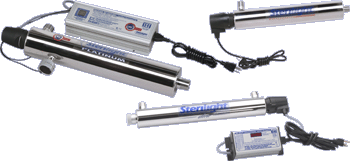Ultra Violet Sterilization
Household Ultra Violet Sterilization
More recently, Ultra-Violet sterilization has been the accepted method of dealing with coloform for more than 50 years.
How the unit works:
An elongated ultra-violet lamp is placed inside of a metal tube. Water travels through this tube and in the process is exposed to the rays from the uv light. The rays change the DNA of the bacteria and in the process, renders the bacteria sterile.

Commercial Systems
We do offer NSF certified products in order that our customers comply with recent legislation regarding these products.
To date, private wells and water supplies are not covered under these legislations.
A manufacturer can send their system to NSF and pay to have them test it to their standards. Systems that pass then carry the NSF-Certified mark. So, how does NSF do their testing? Simply stated, in order for a UV system to pass the NSF testing it must deliver a high level of UV disinfection performance, and must sound an audible/visible alarm if that level of performance is compromised. In order for the system to accomplish this, it needs to have by default a UV sensor and a flow restrictor. NSF Certified UV systems are most typically installed in public water situations such as community centres, churches, schools, etc. Nova Scotia  demands that any UV system installed in any situation must be NSF certified.
Selling Homes & Realty Companies
UV Treatment for Industrial Applications
If you are in charge of an establishment which is noted as public drinking water, you might need our advice or services in order to comply with recent legislation.
UV Irradiation
has emerged as a proven treatment technology for the treatment of process water and wastewater in industrial applications. UV treatment has been established as a low cost, environmentally-friendly treatment technology that provides exceptional disinfection benefits. Exposure to UV irradiation ensures the inactivation of all types of microorganisms, including bacteria, viruses, yeasts, moulds and spores. UV treatment can also be combined with other oxidants (i.e. ozone, hydrogen peroxide) to create hydroxyl radicals for removal of many other harmful contaminants.
UV treatment has numerous advantages in industrial applications. UV treatment can easily inactivate, even with low UV doses, chlorine resistant compounds such as Giardia and Cryptosporidium. UV is a “green technology”, as it is chemical free and produces no disinfection by-products (DBPs). The systems can also be easily retrofitted into existing treatment plants due to its small footprint.
Food & Beverages
UV disinfection equipment can be used prior to filters and/or membranes or after carbon beds to disinfect the source water and minimize microbial contamination at beverage plants, reducing backwashing and servicing frequencies. Waste water streams can also be treated with UV in order to disinfect and reduce BOD levels for safe discharge or reuse.
Power and Cogeneration
UV disinfection equipment can be used prior to RO/UF membranes or mixed bed resins to disinfect and lower TOC levels, reducing backwashing and servicing frequencies, limiting the need for chemical biocides, and minimizing downstream contamination problems.
Oil Fields
UV equipment placed after particle filtration, which minimizes reservoir plugging, disinfects the water to prevent microbial contamination from being injected into the oil reservoir. The use of UV disinfection virtually eliminates the need for water treatment chemicals and expensive dosage monitoring equipment, preventing the chemical composition of the oil from being altered.
Pharmaceuticals and Cosmetics
UV disinfection equipment can be used prior to filters and/or membranes or after carbon beds to disinfect the process water and reduce TOC levels, thereby reducing backwashing and servicing frequencies for downstream treatments. UV equipment can also be implemented in the recirculation line from purified water storage tanks, for residual ozone destruction and to provide additional disinfection and microbial control. Waste water streams can also be treated with UV in order to disinfect for safe discharge. UV can be combined with other advanced treatment technologies (i.e hydrogen peroxide, ozone, etc.) to remove numerous harmful and difficult to remove compounds.
Chemical Processes
UV disinfection equipment can be used prior to filters and/or membranes or after carbon beds to disinfect the process water, reduce TOC levels, minimize microbial contamination, thereby reducing backwashing and servicing frequencies. Waste water streams can also be treated with UV in order to disinfect for safe discharge. UV can be combined with other advanced treatment technologies (i.e hydrogen peroxide, ozone, etc.) to remove harmful and difficult to remove compounds.
Aquaculture
UV disinfection equipment can be positioned after particle filters to disinfect the source water and significantly reduce microbial contamination prior to fish and shellfish exposure. The treatment leads to reduced BOD levels, and reduced disease and mortality of aquatic species.
